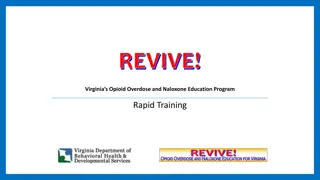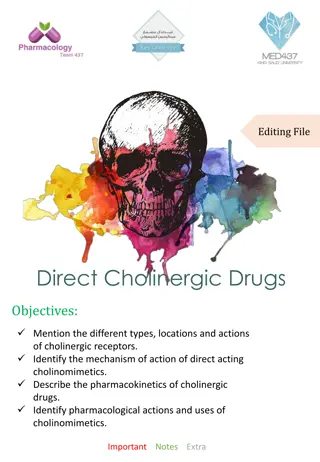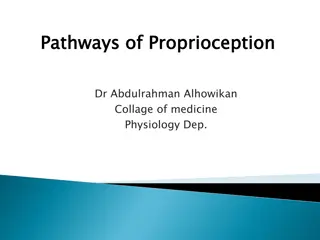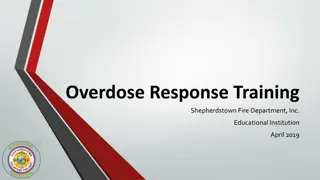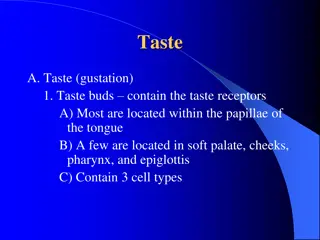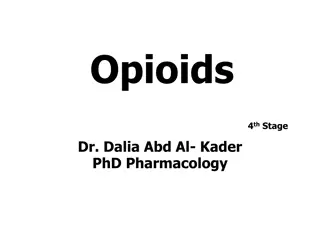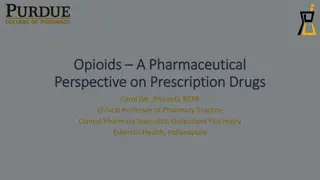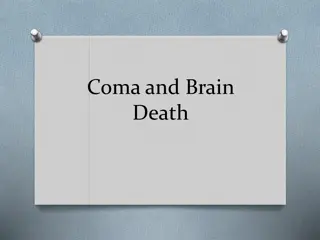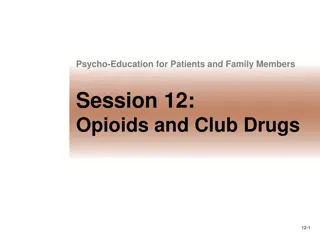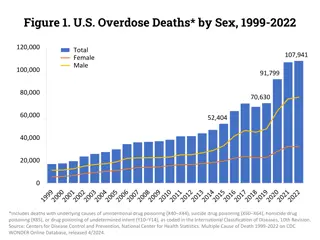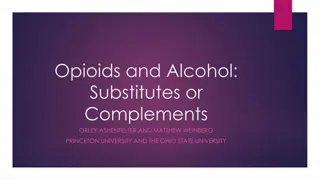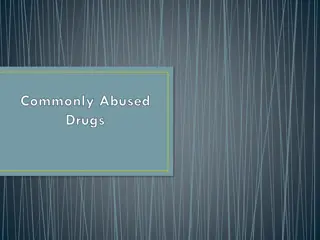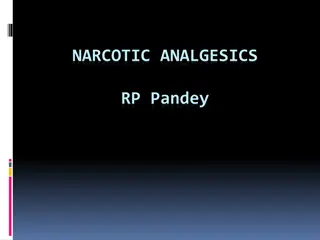Understanding Opioids and the Brain's Receptors
Opioids have a complex history, with substances like opium, morphine, and heroin playing significant roles. The opioid epidemic has highlighted the dangers associated with these drugs, including rising deaths due to fentanyl and synthetic opioids. Questions arise about why the brain has opioid receptors and how behaviors related to pleasure and positive reinforcement are connected to opioid use. Exploring these topics sheds light on the underlying mechanisms driving opioid addiction.
Download Presentation

Please find below an Image/Link to download the presentation.
The content on the website is provided AS IS for your information and personal use only. It may not be sold, licensed, or shared on other websites without obtaining consent from the author. Download presentation by click this link. If you encounter any issues during the download, it is possible that the publisher has removed the file from their server.
E N D
Presentation Transcript
Opioids NORTHEAST SOCIETY OF TOXICOLOGY OCTOBER 20, 2017 JOSHUA GRAY U.S. COAST GUARD ACADEMY LARISSA WILLIAMS BATES COLLEGE photograph by Elizabeth Roy, distributed under a CC-BY-SA 3.0 license.
History of Opium photograph by Sumita Roy Dutta, distributed under a CC- BY-SA 4.0 license. Public domain photograph by KGM007 Opium is an extract of poppy seeds which reduces pain and also produces euphoria. Morphine, named after the god Morpheus, is the most active ingredient of opium. Heroin was synthesized chemically by morphine diacetylation in the late 1800s and was marketed as a non-addictive opiate to treat cough and asthma. Later, it was recognized that heroin was in fact addictive, and heroin and opium were both prohibited in 1910. In the 1970s, it was discovered that there are particular receptors in the brain to which morphine and heroin bind
Vicodin and other oral opioid medicines Hydrocodone semisynthetic opioid Vicodin combination hydrocodone and acetaminophen Oxycodone semisynthetic opioid oxycodone codeine hydrocodone
Opioid Epidemic slide Deaths due to all types of opioids are rising Fentanyl and other synthetic opioids are rapidly becoming a major cause of opioid deaths Source: Centers for Disease Control https://www.cdc.gov/mmwr/preview/ mmwrhtml/mm6450a3.htm
Why does the brain have opioid receptors? INSTRUCTIONS: DISCUSS WITH OTHERS WHY YOU THINK THE BRAIN HAS RECEPTORS FOR OPIOIDS.
What kinds of behaviors do humans do that are associated with pleasure? Emotions have evolved that encourage animals to engage in behaviors with a beneficial outcome and avoid behaviors that could reduce their chance of survival. Positive emotions like pleasure, hedonism, or reward, when associated with the ability to learn from experience, increase the probability of the occurrence of a particular behavior, called positive reinforcement.
Heroin causes a sense of pleasure, or euphoria. What kinds of behaviors are positively reinforced by taking heroin? photograph by Steve pb, distributed under a CC0-1.0 Universal Public Domain license.
Why do opioid users need to escalate their dose? What biochemical mechanism might be playing a part? Typically with opioid addiction, the patient escalates their dose over time, such that a higher dose is required to achieve the same degree of euphoria.
In order for opioids to function, they must get to the brain where they bind to a receptor on the target of the cell. Hypothesize some ways in which the cell might become less sensitive to opioids over time
When the receptor is bound to an opioid, it activates a signaling pathway inside the cell, represented by a star.
What happens to the number of bound receptors if the concentration of opioids changes? The threshold in this example is 5. If 5 or more receptors have opioid bound, a positive signal occurs The number of receptors bound to an opioid molecule depends on the amount of opioids present. At the KM value, half of all of the receptors will be bound. If less than 5 receptors have opioid bound, no signal occurs. Some cells require a certain number of bound receptors to initiate a response. This is called a threshold
What happens if the number of receptors expressed on the cell surface drops? The threshold in this example is 5. If 5 or more receptors have opioid bound, a positive signal occurs The number of receptors bound to an opioid molecule depends on the amount of opioids present. At the KM value, half of all of the receptors will be bound. If less than 5 receptors have opioid bound, no signal occurs. Some cells require a certain number of bound receptors to initiate a response. This is called a threshold
What happens if the cell adapts to higher receptor activation by have a lower response? The magnitude of the response is shown by the size of the yellow star. To achieve the same level of activation, what has to happen in this case? Normal response Weakened response
How would you, as a scientist, design a drug that would help with opioid addiction and withdrawal?
What happens when naloxone is added by itself? Nalaxone is a drug that binds to the receptor but does not activate it. Nalaxone is indicated by a purple circle.
What happens when heroin and naloxone are administered at the same time? Nalaxone is a drug that binds to the receptor but does not activate it. Nalaxone is indicated by a purple circle. Nalaxone is commonly given to people who have overdosed and are comatose.
What happens when buprenorphine is added? Buprenorphene is a drug that binds to the receptor with higher affinity but only partially activates the receptor . It is indicated by a green circle. The magnitude of the response is shown by the size of the yellow star. Normal response Weakened response
Buprenorphine is used as an anti-opioid drug. What happens when heroin and buprenorphine are taken at the same time? The magnitude of the response is shown by the size of the yellow star. Normal response Weakened response
References and resources for more information http://www.pbs.org/newshour/updates/brain-gets-hooked-opioids/ https://www.ncbi.nlm.nih.gov/pmc/articles/PMC2711509/
Acknowledgements All images used in this powerpoint are licensed under a Creative Commons license or are in the Public Domain unless otherwise noted. Images were found on the Wikimedia Commons This PowerPoint was created by Joshua Gray of the U.S. Coast Guard Academy and Larissa Williams of Bates College.
Chemical structures of synthetic opioids photograph by V. H llt and C. Allgaier, distributed under a CC BY-SA 3.0 license.





